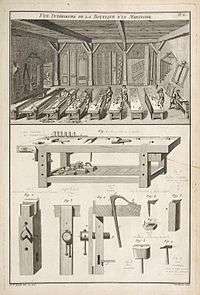André Jacob Roubo

André Jacob Roubo (1739–1791) was a carpenter, cabinetmaker and author. Roubo was born and died in Paris. The son and grandson of master cabinetmakers, he earned that same designation himself in 1774 through the publication of his masterwork treatise on woodworking.
He wrote a highly influential complete treatise on woodworking that covers practically all the associated trades. This multi-volume work, L'Art du Menuisier (The Art of the Joiner), published between 1769 and 1774 by the Académie des Sciences, contains sections and illustrations on: building carpentry, furniture making, and precious woodworking (ébénisterie), carriage making, and garden woodworking.
Roubo's design for a workbench has proven to be popular amongst some modern woodworkers.[1]
Biography
The son and grandson of fellow woodworkers, he was a pupil of the architect Blondel and he received the title of Master in 1770 upon publication of the first part of The Art of the Carpenter. He designed and supervised the construction of the great domes of the halls Wheat and Cloth, and a monumental staircase to the hotel of the Marquis de Marbeuf.
He wrote a comprehensive treatise on carpentry that covers virtually all associated trades. In 1777, he published the first part of a treatise of theater construction and theatrical machinery. The footnotes of these books show that Roubo had an interest in the social status of artisans. In 1789 most of his noble customers had left France; Roubo was nearly financially ruined and was forced to join the National Guard in 1790. Here he achieved the rank of Lieutenant before dying in 1791. He left a widow and four minor children who lived off of his pension in rue Saint Jacques in Paris (formerly parish Saint-Jacques du Haut-Pas). His biography was published in 1836 by the future architect Louis-Auguste Boileau, then a carpenter, in the series "Portraits and History of Useful Men," published by Franklin Montyon and Company.
Works
The Art of the carpenter, published between 1769 and 1782. Republished in 1977 and in 1982, in the format, Leonce Laget. In 2002, the Library Image published an edition at a more affordable price, which also contains The Art of layetier, published in 1782. The work has more than one 340 pages and 389 plates engraved by himself. "The Roubo" is considered even today as the best traditional treated wood joinery. It develops and discusses in detail the technical knowledge of the trades of carpentry that was under Louis XV, in its heyday. In four volumes, the third is the most developed. It deals with dormant carpentry and opening 6, the Bodyshop, furniture manufacturer in seven of the Cabinetmaker and Treillageur. The Treaty of Roubo's de facto guardian of "good practice".
Various "extensions" were given to the 19th and 20th centuries Art of the carpenter, including Dufournet editions Ch Juliot (Paris).; but it does not stay there much of the original work. Regarding the key organ cases, André-Jacob Roubo worked with Dom François Bedos de Celles.
Treated in the construction of theaters and theatrical machinery, and in Jombert Collot in 1777. Reprinted in fac-sim. by Slatkine in 1984 under the false name of "Jacques-André," as part of the collection dummy Arts instruments (ISBN 2051006466). But only the first part (History and architecture of theaters, especially France and Italy) was published even though the second (theatrical Machines) in 1777 was declared "ready to print" so that the title promises more that the book gives. Nevertheless, it is a remarkable work, small in size, with 66 pages of text in two columns and 10 beautiful engravings.
Tributes
There is in Paris' 11th arrondissement since 1850 a Roubo street located in an area inhabited by furniture manufacturers.
See also
Gallery
-

Roubo workbench -

Roubo era saw
Further reading
- Roubo, André Jacob. (2002). Description des arts et des métiers. Le menuisier en bâtiment. Bibliothèque de l'image. ISBN 978-2914661423
References
- ↑ Landis, Scott (1998) The Workbench Book, Taunton Press
External links
| Wikimedia Commons has media related to André-Jacob Roubo. |
- Blog for a project to translate L'Art du Menuisier, with sample section
- New York Public Library Digital Library, images from "L'art du menuisier"